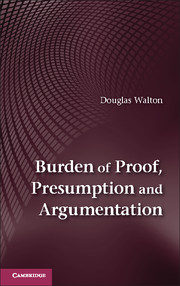Book contents
- Frontmatter
- Dedication
- Contents
- Acknowledgments
- 1 Introduction to Basic Concepts and Methods
- 2 Burdens of Proof in Legal Reasoning
- 3 Presumption in Legal Reasoning
- 4 Shifting the Burden of Proof in Witness Testimony
- 5 Burden of Proof in Dialogue Systems
- 6 Solving the Problems of Burden of Proof
- 7 Burdens of Proof in Different Types of Dialogue
- 8 Conclusions
- Bibliography
- Index
1 - Introduction to Basic Concepts and Methods
Published online by Cambridge University Press: 05 July 2014
- Frontmatter
- Dedication
- Contents
- Acknowledgments
- 1 Introduction to Basic Concepts and Methods
- 2 Burdens of Proof in Legal Reasoning
- 3 Presumption in Legal Reasoning
- 4 Shifting the Burden of Proof in Witness Testimony
- 5 Burden of Proof in Dialogue Systems
- 6 Solving the Problems of Burden of Proof
- 7 Burdens of Proof in Different Types of Dialogue
- 8 Conclusions
- Bibliography
- Index
Summary
A presumption is a device used in the law of evidence to enable a proposition to be taken into account as a piece of evidence in a case even though the argument supporting that proposition is not strong enough for it to meet a required burden of proof. From this definition of what presumption is, we can already see that presumption is linked to burden of proof in evidential reasoning in law. Burden of proof sets a standard for what is to be considered a proof in evidential reasoning in law. It is a device used to make it possible for a trial to arrive at a decision for one side or another in a contested case, even though all the facts of the case may not be known, and for various reasons may never be known. For example, in a criminal case, there may have been no witnesses to the crime, and the crime may have happened a long time ago. Most of the existing evidence may have been lost or destroyed. Therefore, evidential reasoning in law has to be able to move forward to a conclusion under conditions of uncertainty, lack of knowledge and even inconsistency. Typically, for example, in a trial there will be witnesses for one side, but there will also be conflicting testimony on the other side brought in by witnesses who say the opposite thing. What these conditions imply is that in a trial it is rarely if ever possible to prove or disprove the ultimate conclusion beyond all doubt. Hence, the device of having a burden of proof is necessary for the trial to reach a conclusion for one side or the other.
Presumption is not a new notion in legal reasoning. It was a device used in the ancient Jewish law code of the Talmud, and in ancient Roman law. A rough idea of how presumptions work is shown by citing some of the more common examples. According to the presumption of death, a person who has been unheard of for a fixed period of time, varying with the jurisdiction, five years typically in common law, may be presumed to be dead if there is no other explanation of his or her disappearance based on any evidence. Later in this book we will examine an example of another interesting kind of presumption called the presumption of mailing, which presumes that a properly addressed and stamped letter sent by the Postal Service was received by the person to whom it was addressed.
- Type
- Chapter
- Information
- Burden of Proof, Presumption and Argumentation , pp. 1 - 48Publisher: Cambridge University PressPrint publication year: 2014



